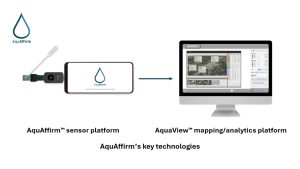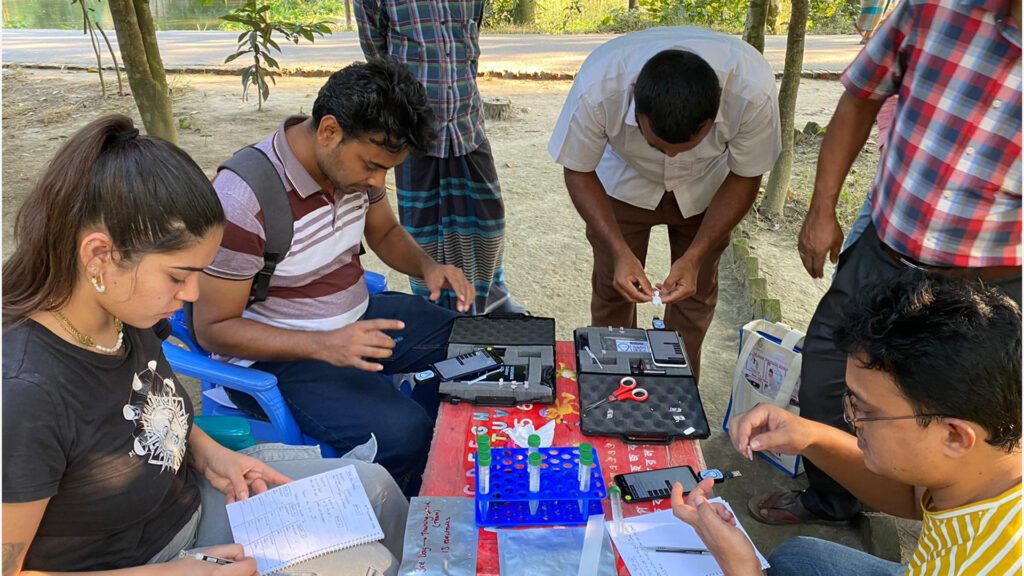Dr David Sarphie, AquAffirm co-founder and CEO, discusses how AquAffirm’s smartphone-powered tech is revolutionising PFAS monitoring – bringing lab-grade testing to the field, and to the world.
“Each time a man stands up for an ideal… he sends forth a tiny ripple of hope…” — Robert F. Kennedy, “Ripple of Hope”, 1966.
Almost six decades after RFK spoke those words, his metaphor is profoundly relevant to efforts in sustainability and environmental justice today. UK biotech AquAffirm is channelling that spirit through its portable, smartphone-enabled water quality sensors for detecting PFAS (per- and polyfluoroalkyl substances) and other water contaminants, reshaping how marginalised communities can fight harmful ‘forever chemicals’ that threaten public health.
What is AquAffirm’s PFAS sensor?
AquAffirm has developed the AquAffirm™ platform: the WORLD’S FIRST portable digital cloud-connected system for water testing powered by a smartphone. Using a combination of disposable test strips, a mobile app, and real-time mapping/data analytics, the system is transforming the way that water is routinely tested and contaminants monitored and mapped. Originally piloted for arsenic in Bangladesh and antibiotic contaminants, the system has now been demonstrated for ‘forever chemicals’ known as PFAS,² specifically detecting perfluorooctanoic acid (PFOA) at ultra-low levels using gold electrode-based strips measured via smartphone and visualised through GIS-enabled mapping.³

This breakthrough matters because conventional PFAS contamination testing depends on costly (~$300-$600 per sample⁴), centralised lab equipment, with delays of days or weeks – often inaccessible to vulnerable populations. AquAffirm’s sensor aims to be low-cost, real-time, and deployable at the point-of-use.
What makes PFAS a crisis of environmental justice?
PFAS compounds are man-made chemicals used in nonstick cookware, stain-resistant textiles, firefighting foams, and more. Known as forever chemicals, they persist indefinitely in soil, water, and human and wildlife tissue.⁵ Even though widespread manufacture and usage are slowly being phased out, legacy PFAS contamination continues to seep into drinking water, often in low-income or rural and minority communities near industrial sites or military bases.
The health consequences – links to cancers, immune dysfunction, reproductive harm, and mental health issues – are especially severe for those already struggling with inadequate healthcare infrastructure.⁶ Because lab testing is expensive, these communities remain uninformed, under-regulated, and under-protected. Thus, the PFAS crisis is fundamentally one of environmental injustice: the privilege of access to clean water is unequally distributed.
AquAffirm’s work through the lens of Kennedy’s ‘Ripple of Hope’
Kennedy’s vision underlines how even small acts – when rooted in conscience – can create powerful waves of change. AquAffirm offers one of those ripples. By placing affordable sensors directly in the hands of affected communities, AquAffirm:
Empowers grassroots detection of PFAS, enabling individuals to hold local authorities and polluters accountable.
Democratises data, feeding into transparent, cloud-based mapping that visualises environmental conditions.
Catalyses advocacy and policy pressure, enabling quicker response to contamination, support for treatment grants (e.g., US EPA’s Bipartisan Infrastructure Law⁷), and robust legislative action.
The ripple begins when a single home owner tests their water – and then dozens, then hundreds, feeding an evidence-based call for justice.
How the tech works: Simplicity + connectivity
The device relies on thin-film, planar gold electrodes screen printed on PET substrates and used as disposable test strips. Working analogously to the well-known diabetes test, a smartphone app measures electrical changes indicative of PFOA, logs the result, and geotags it for real-time mapping. Mapping and data visualisation is carried out by AquAffirm’s AquaView™ software.
Key benefits include:
Speed: instant on-site digital readout.
Affordability: no need for lab-grade instruments.
Portability: ideal for field use.
Scalability: cloud connectivity allows aggregated insights across regions.
Flexibility: initially deployed for arsenic; now scaled to PFAS, antibiotics, salinity and shortly many others.
Use cases & impact
5.1 Community-level testing
Rural towns, tribal lands, and urban neighbourhoods can deploy sensors at shallow wells, schools, and households. When traces of PFOA are found, communities can demand mitigation investments – like those in Massachusetts, where $14.7m funded PFAS remediation in small or disadvantaged communities.⁸
5.2 Environmental consultancies
Environmental consultancies have expressed interest in using AquAffirm’s portable digital tool as part of focused campaigns to address PFAS contamination in their communities, particularly in the USA.
A reliable method for detecting PFAS in water would help identify potential contamination on-site in real time, supporting sampling strategies, including source identification. Real-time, accurate screening like that promised by AquAffirm’s technology can improve overall project efficiency and reduce the number of samples requiring off-site laboratory analysis.
5.3 Regulatory compliance
State-level regulators (e.g., North Carolina DEQ⁹) test for PFAS contamination under new EPA maximum contaminant levels (MCLs) set as low as 4 ppt (parts-per-trillion) for PFOA/PFOS. AquAffirm’s technology provides rapid screening to guide regulatory sampling priorities.
5.4 Incident response
Accidental chemical releases – like firefighting foam spills – require fast response. AquAffirm enables on-site detection to assess plume spread and decide on containment or cleanup action.
5.5 Data-driven mapping
Cloud collation allows civil society, researchers, and governments to visualise hotspots, track exposure trends, and advocate for targeted interventions.
Technical and logistical considerations
In order to develop its proprietary platform as a tool to measure PFAS contamination, AquAffirm has had to consider a number of technical and logistical aspects, including:
Detection threshold: Ability to measure ultra-low levels (~ppt) with a rapid on-site test.
Selectivity: Must avoid false positives from other chemicals in water.
Calibration & validation: Must be rigorously benchmarked against mass spectrometry-based lab techniques.
Durability: Test strips must remain stable in varied field environments.
Accessibility & training: Must be cost-effective (ideally under $50 per test), intuitive to use, and supported with community training.
Alignments with policy & funding trends
AquAffirm’s technology is aligned with current policy and funding trends, including:
US infrastructure investment: EPA-backed funds are driving PFAS cleanup initiatives and grants, favouring low-cost testing tools.10
Global commitments: Europe’s restrictive PFAS proposals and UN water safety goals bolster demand for accessible testing.
Citizen science: Replicable sensor networks create a precedent for independent environmental monitoring.

Potential challenges and obstacles
In order for AquAffirm’s dream of widespread usage of its proprietary platform to become a reality, several key challenges must be acknowledged and addressed. While the vision of community-driven environmental monitoring holds immense promise, its success depends on overcoming structural, technical, and social barriers, including:
Regulatory acceptance
A key question is whether governments and regulatory bodies will trust sensor-generated data for enforcement and compliance purposes. Without official recognition, community-collected data may struggle to influence policy.
Equity of distribution
To be effective, sensor tools must reach underserved and marginalised communities. This requires designing systems that do not depend on high levels of technological literacy or access to expensive infrastructure.
Data integrity
Ensuring the accuracy and authenticity of sensor data is critical. Protections must be in place to prevent falsified readings and misuse of sensitive information like geolocation, which can expose communities to risks.
Long-term funding
Community groups often lack the sustained financial support needed to maintain, calibrate, and operate sensor networks over time. Without reliable funding, these initiatives may fade despite early success.
Yet, this is where the ‘ripple effect’ becomes tangible – each small win (such as generating trusted community data or achieving local remediation) contributes to broader momentum. Over time, these cumulative efforts can drive meaningful regulatory transformation.
The ripple expands: Case scenarios
Case 1: Midwestern farm town
Residents suspect PFAS from the nearby foam testing area. AquAffirm kits reveal worrying levels in private wells. Combined data triggers state intervention and grants for ion-exchange filtration.
Case 2: School near industrial site
Parents deploy sensors and find sporadic spikes in PFOA. Data is elevated during post-rain events—leading to Flint-style exposure alerts, testing of indoor air, and remediation in school grounds.
Case 3: Tribal community
Historic land use led to arsenic and PFAS contamination. AquAffirm allows tribes to run their own testing, document legacy burdens, and secure federal funds for filtration systems.
In each, community actions become ripples that provoke regulatory and infrastructural change.
Going global
AquAffirm aims to expand its platform to measure a broad spectrum of water parameters and contaminants – not limited to PFAS, but also including arsenic, salinity, antibiotics, chlorine, and more. By developing cutting-edge, accessible technology, AquAffirm seeks to empower communities, regulators, and industries with real-time, reliable water quality data. The goal is to support both public health and environmental resilience through scalable, science-based tools. With plans to launch in key global markets – including the UK, US, Middle East, and beyond – AquAffirm is positioned to become a global leader in decentralised water monitoring and to drive meaningful change in how water is managed worldwide.
AquAffirm is partnering with significant players operating globally in the sector, such as the Saudi Water Innovation Center (SWIC) run by the Saudi Water Authority (SWA). Dr Faisal Alosaimi, Director General of the Saudi Water Innovation Center, commented: “At SWIC-SWA, we commend AquAffirm for their innovative low-cost digital sensors that rapidly and effectively measure critical drinking-water contaminants such as arsenic, antibiotics, PFAS, and fluoride. Their advanced technology significantly enhances the speed and accuracy of monitoring, ensuring safer drinking water for communities worldwide.”
Kennedy’s legacy: Moral courage in action
Kennedy urged people to “stand up for an ideal… strike out against injustice,” and these sensor kits do precisely that – fight environmental inequality, catalyse transparency, and empower local voices. The device embodies his ideal: a small tool generating profound hope.

Building the ripple: Recommendations
To maximise impact, AquAffirm’s technology will enable individuals, organisations and campaigners to take action through several key routes which have not been available until now, including:
Partnering with environmental NGOs and local governments to distribute kits in underserved areas.
Accessing open-source data portals to enable community researchers to visualise trends.
Coordinating educational campaigns, teaching interpretation of readings, basic science principles, and the rights to clean water.
Conducting pilots with public health agencies to demonstrate the cost-benefit in disease prevention.
Delivering feedback into regulation, validating sensor outputs to impact policymaking and confirm compliance.
Conclusion: From tiny ripples to waves of change
At its heart, AquAffirm’s sensor is more than a gadget – it’s an act of environmental democracy. When individuals gain tools to detect injustice, change becomes possible.aqu Drawing from Kennedy’s stirring words, every test is a ripple:
A mother tests her drinking water,
A community collects scans,
Regulators see patterns,
Funds flow into treatment,
Innocent children are spared harm.
These chains of small actions cumulate into tidal waves of justice.
“Each time a man stands up for an ideal… he sends forth a tiny ripple of hope…” – AquAffirm offers the sensor; communities unleash that ripple. Over time, those ripples forge a continent of change – and living, safer water.
References
AquAffirm announces successful demonstration of its AquAffirm™ digital sensor networking platform
https://www.epa.ie/publications/monitoring–assessment/waste/65203287-PFOA-EPA-Factsheet-Final.pdf
https://www.aquaffirm.com/
https://www.militarypoisons.org/testing-and-research#:~:text=If%20you%20have%20a%20well%2C%20you%20should%20get,range%20from%20approximately%20%24300%20to%20%24600%20per%20sample.
S.D. Sukhram, et al. 2025. PFAS Exposure, Mental Health, and Environmental Justice in the United States: Impacts on Marginalized Communities. Int. J. Environ. Res. Public Health 22, 1116. https://doi.org/10.3390/ijerph22071116
N. Gaber N, et al. 2023. The Devil they Knew: Chemical Documents Analysis of Industry Influence on PFAS Science. Ann Glob Health. 89(1):37. doi: 10.5334/aogh.4013. PMID: 37273487; PMCID: PMC10237242.
https://www.epa.gov/infrastructure/fact-sheet-epa-bipartisan-infrastructure-law
Healey-Driscoll Administration Awards $14.7 Million to Address PFAS and Other Emerging Contaminants | Mass.gov
DEQ PFAS Sampling of Public Water Systems | NC DEQ
Aqua North Carolina Installs 7 PFAS Treatment Systems to Protect Drinking Water for Thousands of Customers
Please note, this article will also appear in the 23rd edition of our quarterly publication.
Source link

